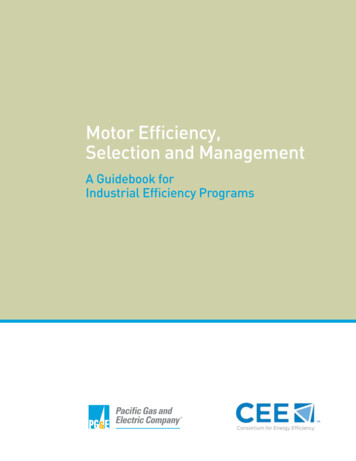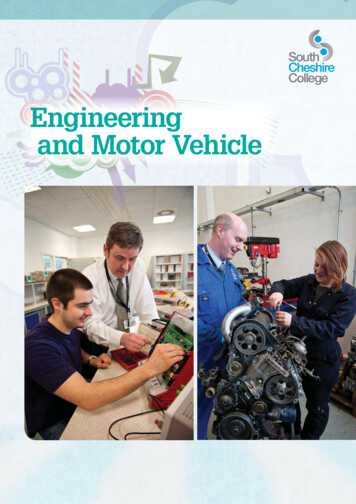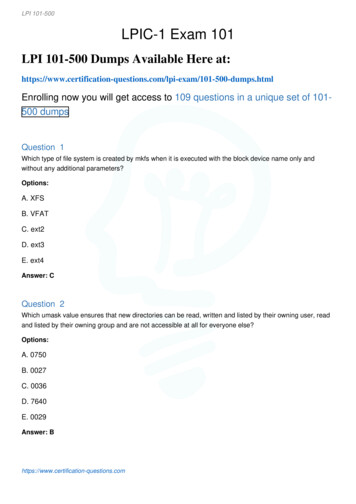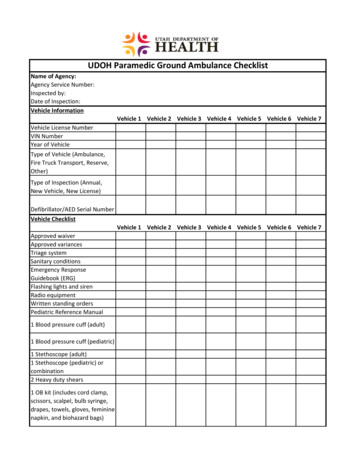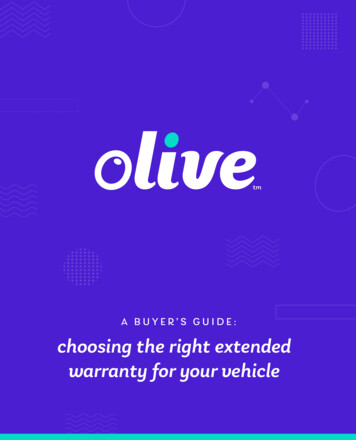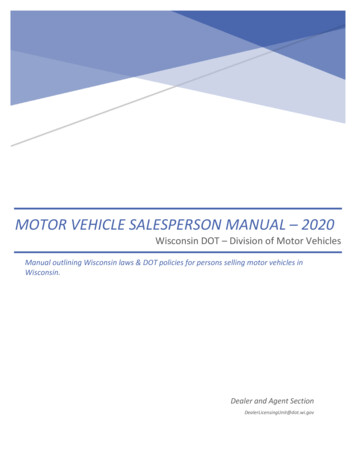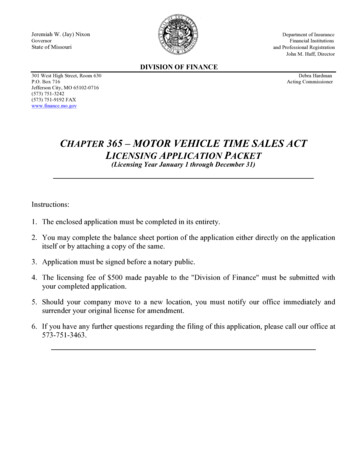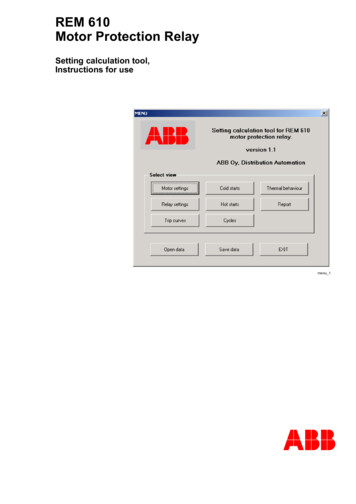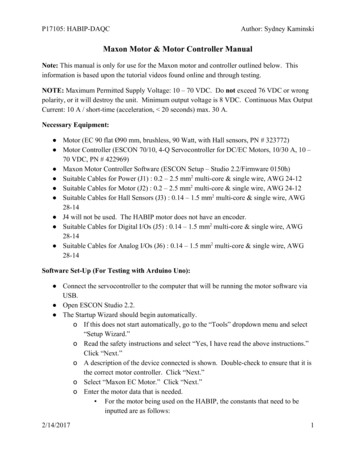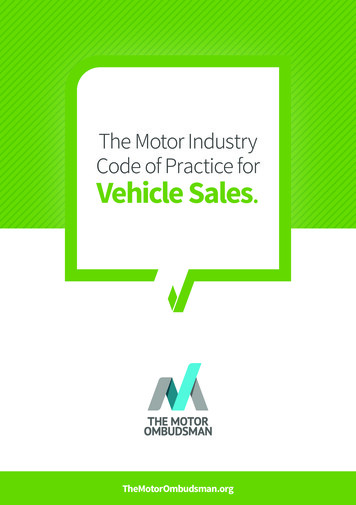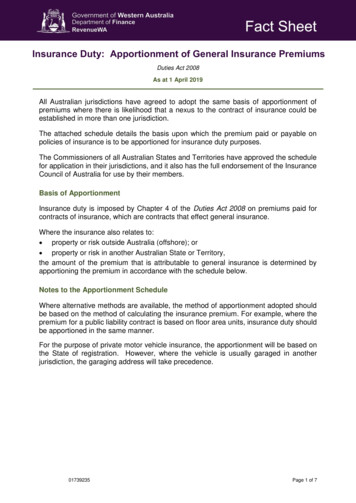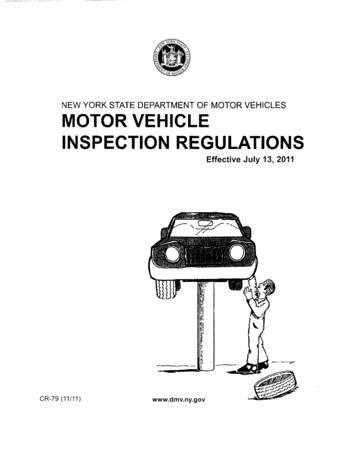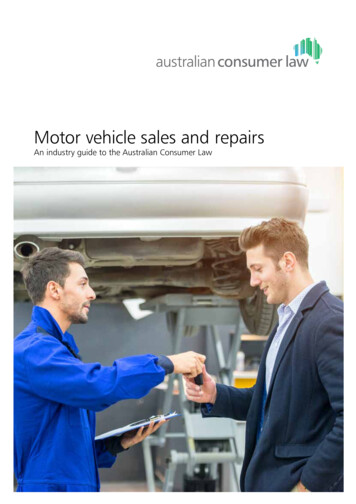
Transcription
Motor vehicle sales and repairsAn industry guide to the Australian Consumer Law
This guide was developed by: Access Canberra, Australian Capital Territory Australian Competition and Consumer Commission Australian Securities and Investments Commission Consumer Affairs Victoria Consumer, Building and Occupational Services Tasmania New South Wales Fair Trading Northern Territory Consumer Affairs Queensland Office of Fair Trading South Australia Consumer and Business Services Western Australia Department of Mines, Industry Regulation and Safety,(Consumer Protection)Copyright Commonwealth of Australia 2018ISBN 978-0-642-74919-2This publication is available for your use under a Creative Commons By Attribution 4.0 Australialicence, with the exception of the Australian Consumer Law logo, photographs, images, signaturesand where otherwise stated. The full licence terms are available from the Attribution 4.0 Unreportedlicence page on the Creative Commons website.Use of Commonwealth material under a Creative Commons By Attribution 4.0 Australia licencerequires you to attribute the work (but not in any way that suggests that the Commonwealth endorsesyou or your use of the work).Material used ‘as supplied’Provided you have not modified or transformed the material in any way, then the Commonwealthprefers the following attribution: Source: Commonwealth of AustraliaDerivative materialIf you have modified or transformed the material, or derived new material in any way, then theCommonwealth prefers the following attribution: Based on the Commonwealth of Australia materialInquiries regarding this licence and any other use of this document are welcome at:ManagerCommunicationsThe TreasuryLangton CrescentParkes ACT 2600Email: medialiaison@treasury.gov.au
CONTENTSIntroduction4Consumer guarantees on vehicles7Consumer guarantees on services25Common issues28Businesses as consumers36Consumer protection agencies37
INTRODUCTIONThe Australian Consumer Law (ACL)is Australia’s national consumer law,replacing previous consumer protectionlaws in the Commonwealth, statesand territories. The ACL applies at theCommonwealth level and in each stateand territory.This guide provides informationon the ACL for the motor vehicle(vehicle) sales and repair industries—including motorcycles.It covers issues about which industrybodies have requested more detailedguidance and which consumers havefrequently reported to national, state andterritory consumer protection agencies.This information will be relevant to: authorised vehicle dealers (includingof vehicles and motorcycles) mechanics and vehicle servicers andrepairers vehicle manufacturers, distributorsand importers.The guide’s main focus is on consumerissues related to defects and failures(both one-off and repeated) in new andused vehicles.4In particular, it provides guidance onthe legal rights and obligations createdby consumer guarantees provided bythe ACL. Remedies are available whenthere is a: major failure to comply with aconsumer guarantee minor failure to comply with aconsumer guarantee that cannot befixed within a reasonable time, or minor failure to comply with aconsumer guarantee that can be fixed(whether or not it is capable of beingfixed within a reasonable time).What is not in this guideThis guide gives general informationand examples—not legal advice or adefinitive list of situations where the ACLapplies. You should not rely on this guidefor complete information on all yourobligations under the ACL.In addition, this guide does not coveryour obligations under state and territoryvehicle trader licensing laws; e.g. theMotor Dealers and Repairers Act 2013(NSW).
Other ACL guides andinformationTerminologyThis guide supplements the ACL guidesfor business and legal practitioners,available from the Australian ConsumerLaw website: Consumer guarantees Sales practices Avoiding unfair business practices A guide to unfair contract terms law Compliance and enforcement: howregulators enforce the AustralianConsumer Law Product safety.A manufacturer is a business thatmakes or puts products together or hasits name on the products. It includesthe importer, if the maker does not havean office in Australia, and/or any agent(including a distributor) which holds itselfout to the public as the manufacturer orofficial importer of the vehicles. Examplesof manufacturers include Ford, Holden,Hyundai, etc.For more information, visit:Australian Consumer Law websiteAustralian Competition and ConsumerCommission (ACCC) website.State and territory consumerprotection agenciesAustralian Capital Territory: AccessCanberra websiteNew South Wales: Fair Trading websiteNorthern Territory: Consumer AffairswebsiteQueensland: Office of Fair TradingwebsiteSouth Australia: Consumer and BusinessServices websiteTasmania: Consumer, Building andOccupational Services websiteVictoria: Consumer Affairs VictoriawebsiteWestern Australia: Department of Mines,Industry Regulation and Safety (ConsumerProtection) websiteFor the purposes of this guide:A dealer is any business that suppliesvehicles to consumers, including: new vehicle dealers that areauthorised by manufacturers,usually via a franchise agreement(often referred to as a dealeragreement), to be the primary sellerof the manufacturer’s vehicles andreplacement parts produced by, or for,an original equipment manufacturer,and also a provider of authorisedrepair and servicing for new and usedvehicles, within a defined geographicarea used vehicle dealers that supplyused vehicles to consumers, and alsorepair and service new and usedvehicles, generally with no officialendorsement by or affiliation withthe manufacturer.An independent repairer is abusiness that repairs and servicesvehicles, but is not officially endorsedby or affiliated with the manufactureror dealer. Examples of independentrepairers include smaller owner-operatorworkshops and larger conglomerates(e.g. Kmart Tyre & Auto Service, MidasAustralia, Ultra Tune, etc.).A guide to Australian consumer law —Motor vehicle sales and repairs5
Trade or commerce means in thecourse of a manufacturer’s or dealer’sor independent repairer’s business orprofessional activity, including a not-forprofit business or activity.A consumer is a person who buys any ofthe following: any type of products or servicescosting up to 40 000 (or any otheramount set by the ACL in future) a vehicle or trailer used mainly totransport goods on public roads.The cost of the vehicle or trailer isirrelevant products or services costing morethan 40 000, which are of a kindordinarily acquired for personal,domestic or household purposes(such as the family car).6A person is not a consumer if they buyproducts to: on-sell or resupply use, as part of a business, to:– manufacture or produce somethingelse (for example, buying rubber tomake tyres)– repair or otherwise use on othergoods or fixtures.Major failure and minor failure referto failures to comply with consumerguarantees. The ACL does not use theterm ‘minor’; it only makes reference toa failure that is ‘major’ and ‘not major’.However, throughout this guide theterm ‘minor failure’ is used for simplicityand will apply to circumstances where afailure will not be major.A representation is a statementor claim.
CONSUMER GUARANTEES ONVEHICLESUnder the ACL, there are numerous consumer guarantees that apply to new andused vehicles sold to a consumer. Table 1 outlines the automatic, statutory consumerguarantees relating to the supply of vehicles.Table 1: The consumer guarantees relating to the supply of vehiclesA supplier guarantees:*A manufacturer guarantees: goods will be of acceptable quality** goods will be fit for any purposedisclosed before sale goods will match their description goods will match the sample ordemonstration model they will honour any expresswarranties consumers have title to the goods consumers have undisturbedpossession of the goods there are no undisclosed securities onthe goods goods will be of acceptable quality** goods will match their description they will honour any expresswarranties they will make available repairfacilities or spare parts for areasonable time* For the purpose of the ACL, the term ‘supplier’ refers to dealers. The term ‘supplier’ would also refer to amanufacturer if it sells or otherwise supplies vehicles directly to consumers, including via online platforms; thiswould be in addition to their inherent classification under the ACL as ‘manufacturers’.** Goods are of acceptable quality if they are safe, durable and free from defects, are acceptable in appearanceand finish and do everything that they are commonly used for (see page 11).A guide to Australian consumer law —Motor vehicle sales and repairs7
Vehicles bought from privatesellersVehicles bought from one-off salesby private sellers are only covered bythe guarantees as to title, undisturbedpossession and undisclosed securities.However, the implied warrantiesunder state and territory sale of goodslegislation also apply to private sales,unless excluded by the contract.Sometimes vehicle sellers have ‘linkedcredit providers’—for example, a financecompany to which they regularly referpeople under an agreement withthat company. These credit providerscan be liable under the ACL for theloss or damage someone sufferswhen that seller fails to meet certainconsumer guarantees.Vehicles bought at auctionOther exclusionsVehicles bought by way of ‘sale byauction’ are only covered by theguarantees as to title, undisturbedpossession and undisclosed securities.A ‘sale by auction’ is an auction that isconducted by an agent (or auctioneer),whether the agent acts in person or byelectronic means. Not all auctions are‘sales by auction’, for example, auctionsconducted by eBay are not considered as‘sales by auctions’, because eBay does notact as the agent (or auctioneer) for theperson supplying the goods.Other types of vehicles not covered byconsumer guarantees include those: bought before 1 January 2011. Theseare covered by statutory impliedconditions and warranties under theTrade Practices Act 1974 and state andterritory legislation in force before 1January 2011 bought to on-sell or resupply. Thesesales are covered by the impliedfitness for purpose warranties understate and territory sale of goodslegislation, unless excluded bythe contract.However, the implied warrantiesunder state and territory sale of goodslegislation apply to auction sale contracts,unless excluded by the contract.Leased or hired vehiclesLeased or hired vehicles are coveredby the consumer guarantees, with theexceptions of the guarantees as to titleand undisclosed securities. The guaranteefor undisturbed possession applies onlyfor the term of the lease or hire.For more information on rental vehicles,see the Australian Consumer Law industryguide: rental cars, available from theAustralian Consumer Law website.8Linked credit providers
Interaction between warrantiesand consumer guaranteesA warranty does not change yourresponsibilities under the ACL. Consumerguarantees cannot be replaced, limitedor removed by any agreement, contractor warranty. Consumer guarantees applyfor an unspecified but reasonable period,to be determined by a range of factors,including the nature and cost of thegoods. The consumer guarantees applyin the same way regardless of whethera vehicle is covered by a manufacturer’swarranty, an express warranty or anextended warranty, and consumerguarantees may continue to provideprotections after warranties have expired(warranties are discussed further atpage 20).When explaining customers’ rights underwarranty, you should be careful not torepresent that customers have no otherlegal right to address a defect. To ensureyou do not risk breaching the ACL whendealing with your customers, you shouldensure that consideration of customers’consumer guarantee rights and yourobligations as either a manufactureror dealer are embedded in all systems,policies and procedures that make upyour complaints handling system. Anupdated complaints handling system will,as a matter of best practice, help ensurethat a consumer’s statutory rights underthe ACL are given due consideration atthe outset of responding to a claim.Figure 1: Remedies from consumer guarantees and warrantiesConsumer guaranteesConsumer hasconsumer guaranteerights (which may bemore extensive thanwarranty rights)e.g. if a major failureoccurs outside ofwarranty period.WarrantyConsumer hasrights underconsumerguaranteesand warranty.Consumer haswarranty rights(which may bemore extensivethan consumerguarantee rights).No right available (e.g because the problem was casued by consumer misuse).A guide to Australian consumer law —Motor vehicle sales and repairs9
Example 1:A vehicle that was just over three yearsold suffered from a manufacturingdefect that resulted in excessive jerkingand shuddering when accelerating tosuch an extent that the vehicle was notdrivable. The vehicle was substantiallyunfit for its normal purpose becausedespite many attempts at a repair, thedealer could not permanently fix theissue (see also discussion about ‘majorfailure’, at page 12). The vehicle hasfailed to meet the consumer guaranteeof acceptable quality. As the vehicleis not drivable, the failure wouldconstitute a major failure to complywith a consumer guarantee.The dealer cannot avoid providing aremedy merely because the problemoccurred one month after the expiry ofthe manufacturer’s three year warrantyperiod applicable for that vehicle(or 1000 kms after the 100 000 kmwarranty distance, as the case maybe). If the defect is a manufacturingdefect, then the consumer mayreject the vehicle and ask whoeversupplied the vehicle (e.g. the dealer)to provide the consumer’s choice of arepair, replacement or refund underthe consumer guarantee provisions,regardless of whether the warrantyhas expired.There are several factors that make itreasonable for a consumer to reject avehicle in response to a major failure(and seek a refund/replacement), morethan three years after purchase. Thesefactors include that the consumer’s useof the vehicle was consistent with areasonable consumer’s likely use, andthat it would be reasonable for thevehicle to be used for longer than three10years before the manufacturing defectbecomes apparent (see discussion aboutthe ‘rejection period’, at page 15).Example 2:A manufacturing defect prevented atwo-year-old vehicle from shifting intoreverse gear. The vehicle has failedto meet the consumer guarantee ofacceptable quality. The dealer spenttwo months unsuccessfully attemptingto repair the vehicle, and the consumerthen requested a replacement or refundunder the consumer guarantees. Giventhe vehicle failed to meet a consumerguarantee and could not be repairedwithin a reasonable time (see discussionabout ‘major failure’, at page 12), thefailure is a major failure to comply witha consumer guarantee. The consumermay reject the vehicle and ask whoeversupplied the vehicle (e.g. the dealer) toprovide a replacement or refund underthe consumer guarantee provisions.This applies regardless of whetherthe vehicle may have been able tobe repeatedly repaired under themanufacturer’s warranty. The consumermay, however, wish to keep the vehicleand have it repaired, in which casethe dealer is entitled to repair thevehicle rather than replace it or providea refund.
As a matter of best practice, and alsoto minimise the risk of contravening theprovisions of the ACL, which prohibitmisrepresentations and misleadingor deceptive conduct (e.g. where theconsumer has requested a remedyunder the consumer guarantees), youshould also: when providing a remedy, make itclear to the consumer when youare providing remedies under theconsumer guarantee provisions—rather than simply describing suchremedies as ‘goodwill’ when not providing a remedy,consider providing consumers withwritten reasons for refusing toprovide a remedy under the consumerguarantee provisions.Acceptable qualityThe test for acceptable quality is whethera reasonable consumer, fully acquaintedwith a vehicle’s condition (including anydefects) would find it: fit for all the purposes forwhich vehicles of that kind arecommonly supplied acceptable in appearance and finish free from defects safe durable.This test takes into account: the nature of the vehicle, for example:– a new vehicle would be expected tolast longer than a used vehicle– a dedicated four-wheel-drive vehiclemay have a higher standard for offroad use than a ‘soft off-roader’ – a high-performance vehicle mayrequire more maintenance to keepup its performance levelthe price of the vehicle, for example,a consumer may reasonably expect atop-of-the-range model in a particularvehicle class to be more durable thana cheaper competing model in thesame classrepresentations made aboutthe vehicle; for example, in anyadvertising, on the manufacturer’sor dealer’s website or in thevehicle manualanything the dealer told the consumerabout the vehicle before purchaseany other relevant facts, such as theway the consumer has driven or usedthe vehicle.The guarantee of acceptable quality doesnot apply if: the dealer alerts the consumer tothe defect in the vehicle before theconsumer agrees to the purchase the consumer examines the vehiclebefore buying and the examinationshould have revealed it was not ofacceptable quality. The examinationdoes not require the consumer tofind hidden defects or ones thatare difficult to detect; for example,engine, brake or gearbox faults, whichmay not be easily detected the consumer causes the vehicle tobecome of unacceptable quality ordoes not take reasonable steps toprevent the vehicle from becomingof unacceptable quality, for example,the consumer puts petrol in adiesel vehicleA guide to Australian consumer law —Motor vehicle sales and repairs11
the consumer uses the vehicle in anabnormal way. ‘Abnormal’ use hasnot been defined under the ACL.However, certain uses for vehicles willbe inherently abnormal, for example,a small hatchback is not designedfor towing a horse float. Informationprovided in the manufacturer’shandbook and any other operatinginstructions may also be relevant.Major vs minor failuresWhen a vehicle fails to meet a consumerguarantee, your rights and yourobligations to the vehicle owner dependon whether the failure is major or minorand whether you sold or otherwisesupplied the vehicle to the consumer(e.g. see reference to ‘supplier’ in table 1and table 2).Major failuresA major failure to comply withthe consumer guarantees includesthe following: a reasonable consumer would nothave bought the vehicle if they hadknown about the full extent of theproblem. For example, no reasonableconsumer would buy a new vehiclewith so many recurring faults thatthe vehicle has spent more time offthe road than on it because severalqualified repairers have been unableto solve the problem the vehicle is significantly differentfrom the description, sample ordemonstration model shown to theconsumer. For example, a consumerorders a vehicle with a diesel engineafter test-driving the demonstrationmodel, but the vehicle delivered has apetrol engine12 the vehicle is substantially unfit for itsnormal purpose and cannot easily bemade fit within a reasonable time. Forexample, the engine of a vehicle witha stated towing capacity of 3500 kgsand normally used for towing, has adesign flaw that cannot be easily fixedwhich causes it to overheat when ittows a load of more than 2500 kgs the vehicle is substantially unfit fora purpose that the consumer toldthe dealer about, and cannot easilybe made fit within a reasonabletime. For example, a vehicle doesnot have enough towing capacityto tow a consumer’s boat, despitethe consumer telling the dealerthe specifications required to towthe boat the vehicle is unsafe. What is ‘unsafe’will depend on the circumstances ofeach case. For example, a vehicle hasfaulty brakes that cause the vehicle torequire a significantly greater brakingdistance than would be safe fornormal use.When there is a major failure to complywith a consumer guarantee, theconsumer can choose to: reject the vehicle and choose a repair,refund or an identical replacement(or one of similar type and value ifreasonably available) from whoeversupplied the vehicle (e.g. thedealer), or
keep the vehicle and ask forcompensation, from the dealer or themanufacturer, for any drop in its valuecaused by the failure of the vehicle tocomply with a consumer guarantee,and compensation for any reasonablyforeseeable loss suffered due to thefailure of the vehicle to meet theconsumer guarantees.Additional guidance on criteria fordetermining a major failureWhile examination of a vehicle willlikely be required to identify the natureof a fault, the ACL does not requirean involved process of diagnosis todetermine if a vehicle’s failure is ‘major’.You should approach consumer claims forremedies from the perspective of whethera reasonable consumer would havebought the vehicle if they had known ofthe full nature and extent of the failure atthe time of purchase. In particular: if a manufacturing defect causes avehicle to become immobile and notdrivable, and this defect cannot beeasily repaired with the result that thevehicle is not able to be used withina reasonable time, this is likely toconstitute a major failure to complywith the consumer guarantee ofacceptable quality where a vehicle experiences multipleminor failures which necessitatemultiple or repeated repairs with theresult that the vehicle cannot be usedby the owner for unreasonable periodsof time (e.g. because the vehicle isnot in the owner’s possession), this islikely to constitute a major failure tocomply with the consumer guaranteeof acceptable quality.Example 1:Within the first 60 days after purchase,a manufacturing defect caused a vehicleto become immobile and not drivable,and the dealer was unable to repairthe vehicle within a reasonable numberof days. The vehicle is unlikely to meetthe consumer guarantee of acceptablequality, and a reasonable consumer isunlikely to have bought a vehicle if theyhad known the vehicle would developsuch serious defects shortly afterpurchase. Therefore, the failure is likelyto be a major failure of the vehicle tocomply with the consumer guarantee ofacceptable quality.Example 2:Shortly after purchase, a manufacturingdefect caused a vehicle to developexcessive noisiness. During eachattempted repair, the vehicle wasnot able to be used by the consumerfor extended periods (e.g. becausethe vehicle was not in the owner’spossession), for a combined periodof five weeks. The vehicle is unlikelyto meet the consumer guarantee ofacceptable quality, and moreover, areasonable consumer is unlikely tohave bought a new vehicle if they hadknown the full extent of the vehicle’sproblems. Therefore, the failure is likelyto be a major failure of the vehicle tocomply with the consumer guarantee ofacceptable quality.A guide to Australian consumer law —Motor vehicle sales and repairs13
Example 3:A vehicle is approximately three yearsold. During the three years, a fewrelatively minor issues have occurred.Firstly, after about one year, a piece ofinterior trim came loose and the dealerwas able to repair it. After about twoyears the satellite navigation systemdeveloped a glitch, which the dealerwas easily able to fix with a softwareupdate. At three years of age, the bootlatch broke, which the dealer was ableto quickly and easily replace. Eachissue was able to be easily repaired,and the vehicle was able to be usednormally. Therefore, even though eachindividual failure is likely to be a minorfailure of the vehicle to comply withthe consumer guarantee of acceptablequality, these failures, which occurredover a three-year timeframe and do notreflect a recurrent or systemic issue, donot constitute a major failure.Minor failuresMinor failures to comply with theconsumer guarantees of acceptablequality or fitness for purpose includethose where a vehicle has a fault thatsignificantly affects its operation, but canbe fixed within a reasonable time. Forexample: a vehicle where the windscreen wipersstop working a vehicle fault that can be rectifiedwith a software update a vehicle with a small fault in itstransmission, which the manufacturercan quickly resolve by, for example,replacing the entire transmissionrather than repairing only thefaulty component.14A minor failure does not initially allowthe consumer to reject the vehicleand demand a refund, replacementor compensation for the difference invalue—even if the vehicle is immobileand not drivable for a short period oftime (e.g. several days).Example:A consumer buys a new vehicle, andit soon develops a slight rattling noisethat does not interfere with its normaloperation. The consumer returns thevehicle to the dealer, who inspectsit, determines the cause of the noiseand offers to repair it in two days.The consumer refuses this offer anddemands a refund, claiming a majorfailure to comply with the guarantee ofacceptable quality. However, in thesecircumstances, the fault would mostlikely be considered a minor failure,if capable of being fixed within areasonable time. The dealer would nothave to offer a refund in this case.When the failure to comply with aconsumer guarantee is minor, you arenot held to repairing it. You can choosebetween providing a repair or offeringthe consumer a refund or an identicalreplacement (or one of similar value ifreasonably available).If you have identified a minor failure,but have not been able to fix it withina reasonable time, the consumer canchoose to get the job done elsewhereand charge you the reasonable costsof this repair or can treat the failureas major. This applies even if the delayis due to unavailability of parts. See‘Inability to repair within a reasonabletime’ on page 16.
Major failure—when consumers arenot entitled to reject goodsA consumer cannot reject a vehicle if the: rejection period has passed consumer has lost, destroyed ordisposed of the vehicle vehicle was damaged after beingdelivered to the consumer vehicle, part or component has beenattached to, or incorporated in,some other property and cannot bedetached without damaging it consumer has caused the problemthrough their own action orinaction—see ‘Abnormal use’.The ‘rejection period’ is the periodcommencing from the time a consumerbought a vehicle, during which it wouldbe reasonable to expect a problemto appear.The length of a vehicle’s ‘rejection period’is yet to be the subject of significantjudicial consideration, however, thereis nothing in the ACL to suggest thatits application is related to the conceptof warranties. It is therefore entirelypossible that the warranty period canend before the rejection period ends. Itis also possible that a latent defect doesnot become ‘apparent’ until it has beenidentified and diagnosed. In determiningwhether the rejection period has passed,it is relevant to consider the: type of vehicle way in which the consumer is likely touse it length of time, and amount of use,that would reasonably be expectedto elapse before the problembecomes apparent.Abnormal useVehicles are not expected to beindestructible; a consumer’s use of avehicle can affect its durability.The guarantee of acceptable quality willnot apply if the consumer: uses a vehicle abnormally causes the quality of a vehicle tobecome unacceptable fails to take reasonable steps to avoidthe quality becoming unacceptable.The law does not define ‘abnormal use’.However, examples of abnormal usewould include: a soft-top vehicle is left out in therain with its roof open, resulting indamage to the interior a two-wheel drive vehicle beingconsistently driven in lower tractionover rough surfaces that are bettersuited for four-wheel-drive vehicles.There is a difference between damagecaused by abnormal use, and gradualdeterioration (also called ‘wear andtear’) caused by a consumer’s normaluse of a vehicle. Wear and tear involvesthe eventual wearing out of parts to thepoint where they no longer work, as wellas such things as scuffing, scratching ordiscolouration that would predictablyoccur over time when the vehicle is usednormally. Normal wear and tear is not aminor or major failure.If a consumer uses a vehicle normally,and its condition deteriorates faster orto a greater extent than would usuallybe expected, then the vehicle mayhave failed to meet the guarantee ofacceptable quality and the consumer maybe entitled to a remedy.A guide to Australian consumer law —Motor vehicle sales and repairs15
Example:A consumer buys a new vehicle,and takes due care to maintain thecondition of the vehicle’s exterior. Oneyear after purchase the dealer conductsa routine service and determines thevehicle needs to be repainted to preventthe onset of rust. The dealer cannotrefuse to repaint the vehicle by claimingthe consumer’s use of the vehiclewas abnormal.Inability to repair within a reasonabletimeA reasonable repair time, for the purposeof determining whether a fault is major,is assessed taking into account the natureof the problem and the difficulty inidentifying it. Otherwise, the assessmentis on the basis of all things beingnormal or equal; for example, that partsare available.A failure that is initially assessed asminor but which is not fixed within areasonable time, for example, becauseparts subsequently become unavailable,or because of any other reason beyondyour control) gives the consumer the rightto reject the vehicle. If multiple repairattempts are required to remedy a singleminor failure, which is indicative of asystemic problem, you should considerthe combined length of all the repairattempts (and not the individual length ofeach repair in isolation), when deciding ifthe repair time is ‘reasonable’.Similarly, if multiple repair attemptsare required to remedy different typesof minor failure, this may ultimatelyconstitute a major failure of theguarantee of acceptable quality, forexample if
Consumer Affairs Victoria Consumer, Building and Occupational Services Tasmania New South Wales Fair Trading Northern Territory Consumer Affairs Queensland Office of Fair Trading South Australia Consumer and Business Services Western Australia Department of Mines, Industry Regulation and Safety, (Consumer Protection)
